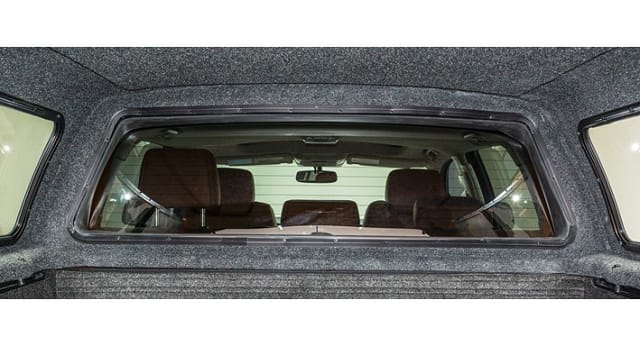Camper Shell Lining – also known as a truck cap or canopy- is a popular addition to trucks for those who love the outdoors or need extra storage and protection. While the exterior of the camper shell provides coverage from the elements, the interior lining plays a crucial role in enhancing comfort, durability, and functionality. This article explores the importance of camper shell lining, the materials commonly used, and the benefits of lining your camper shell.
Why You Need Camper Shell Lining
The lining of a camper shell serves multiple purposes that improve both the aesthetics and practicality of the shell. Here’s why lining is an essential component for anyone using a camper shell:
1. Insulation
One of the primary reasons to add lining to a camper shell is to improve insulation. Whether you use the camper shell for storage or as a sleeping area, proper insulation ensures that the space stays cooler in the summer and warmer in the winter. Without insulation, the camper shell can turn into an uncomfortable environment, especially during extreme weather conditions.
2. Noise Reduction
The metal or fiberglass construction of most camper shells can amplify road noise, making for a louder, more disruptive ride. Camper shell lining absorbs sound, creating a quieter environment inside the truck bed. This is particularly beneficial if you plan to camp in the back or transport sensitive cargo.
3. Protection Against Condensation
Without proper lining, condensation can build up inside, especially in humid or cold environments. This moisture can lead to mold, mildew, and rust, potentially damaging the camper shell and anything stored inside. A lined camper shell helps prevent condensation by regulating the temperature and keeping moisture at bay.
4. Aesthetic Appeal
Beyond its functional benefits, a well-lined camper shell adds a layer of aesthetic appeal. It gives the interior a finished look, making it feel more like a cozy, usable space rather than just an extension of your truck bed. This is especially important if you plan on using the space for camping or recreational purposes.
5. Improved Durability
The lining adds an extra layer of protection to the inside of the shell. It helps prevent scratches, dents, and other forms of damage that can occur when loading or unloading cargo. By protecting the shell’s interior, lining ensures that your camper shell will last longer and remain in better condition over time.
Common Camper Shell Lining Materials 
Several types of materials can be used for <strong>camper shell lining, each offering different benefits. The choice of material depends on your specific needs, whether you’re looking for enhanced insulation, soundproofing, or durability.
1. Carpet Lining
One of the most popular options for <strong>camper shell lining is carpet. Carpet provides excellent insulation and noise reduction, creating a comfortable environment for sleeping or storage. It’s also a cost-effective option that is relatively easy to install.
Pros:
- Excellent insulation properties
- Reduces noise
- Affordable and easy to install
Cons:
- Can absorb moisture if not treated properly
- May require more maintenance to prevent mold or mildew
2. Foam Insulation
Foam is another excellent choice for lining camper shells, particularly for those who prioritize thermal insulation. Foam linings are lightweight and can be installed under other materials like carpet or vinyl for added comfort.
Pros:
- Superior thermal insulation
- Lightweight and easy to install
- Versatile and can be paired with other materials
Cons:
- Can be prone to damage if left exposed
- May not offer the best aesthetic finish without a covering
3. Vinyl or Rubber Lining
Vinyl or rubber linings are favored for their durability and water-resistant properties. These materials are often used for truck bed liners, but they can be equally effective in camper shells, especially for those who use their truck for heavy-duty work.
Pros:
- Highly durable and resistant to wear
- Water-resistant and easy to clean
- Provides a professional, rugged look
Cons:
- Less comfortable for sleeping or recreational use
- Can be more expensive than other materials
4. Spray-On Liner
For those looking for a long-lasting and custom-fit solution, a spray-on liner can be an excellent choice. These liners offer excellent protection against moisture, impact, and wear, making them ideal for heavy-duty use.
Pros:
- Durable and long-lasting
- Completely seals the interior, protecting against moisture and damage
- Custom fit to the specific contours of your camper shell
Cons:
- Permanent once applied
- Can be more expensive and requires professional installation
5. Upholstered Lining
For a more luxurious feel, many choose upholstered linings for their camper shell. Upholstery adds both comfort and a stylish finish, making the interior feel more like a traditional living space.
Pros:
- High-end aesthetic appeal
- Comfortable and soft to the touch
- Customizable to fit personal style preferences
Cons:
- More expensive than other materials
- May require more maintenance to keep clean and free from damage
How to Install Camper Shell Lining
The installation can vary depending on the material you choose. Some linings, like carpet or foam, can be installed as a DIY project, while others, like spray-on liners, require professional help. Here’s a general guide on how to line a camper shell:
Step 1: Clean the Interior – Camper Shell Lining</strong>
Before applying any lining, it’s important to thoroughly clean the inside of the camper shell. Remove any dirt, debris, or moisture to ensure that the lining adheres properly and lasts longer.
Step 2: Measure and Cut the Material – Camper Shell Lining</strong>
For materials like carpet or foam, measure the dimensions of your camper shell’s interior. Cut the material accordingly, ensuring you have enough to cover all sides, including the ceiling if desired.
<strong>Step 3: Apply Adhesive – Camper Shell Lining</strong>
Use a strong adhesive designed for your lining material. Apply the adhesive evenly across the surfaces where the lining will be installed. For materials like foam, spray adhesives are often the best choice.
Step 4: Install the Lining
Carefully place the lining material in position, pressing it firmly to ensure a strong bond. If you’re using multiple pieces of material, ensure that the seams are aligned and smooth.
Step 5: Finishing Touches
Once the lining is installed, check for any air bubbles or loose areas. Make any necessary adjustments to ensure a clean, professional finish.</p>
<h2>Maintaining Yo
<p>ur Camper Shell Lining</p>

<p>To ensure that your <strong>camper shell lining stays in great condition, regular maintenance is key. Here are some tips for keeping it clean and functional:
-
-
- Clean Regularly: Depending on the material, vacuum, wipe, or wash the lining regularly to prevent dirt build-up and wear.
- Check for Moisture: Ensure there is no moisture trapped between the lining and the shell, as this can lead to mold and mildew.
- Repair Damage Promptly: If you notice any tears or damage to the lining, repair it immediately to prevent further issues.
&
lt;/ul></
- ul>
-
<h2><strong>Conclusion: Enhancing Your Camper Shell with the Right Lining</h2>
<p>The right <strong&</p>
gt;camper shell l
ining can transform your truck into a more comfortable, functional, and durable space. Whether you prioritize insulation, noise reduction, or aesthetic appeal, there’s a lining material that fits your needs. By choosing the right material and maintaining it properly, you can enjoy a camper shell that meets all your adventure or work-related demands for years to come. linexroundrock
 Trucks for Sale Find the best deals on used trucks for sale across the USA. Browse pickups, semi trucks, dump trucks and more – updated daily
Trucks for Sale Find the best deals on used trucks for sale across the USA. Browse pickups, semi trucks, dump trucks and more – updated daily



